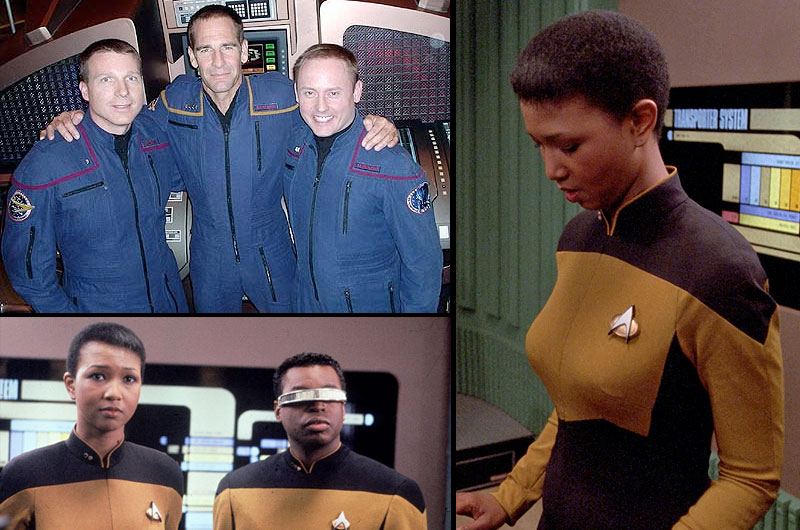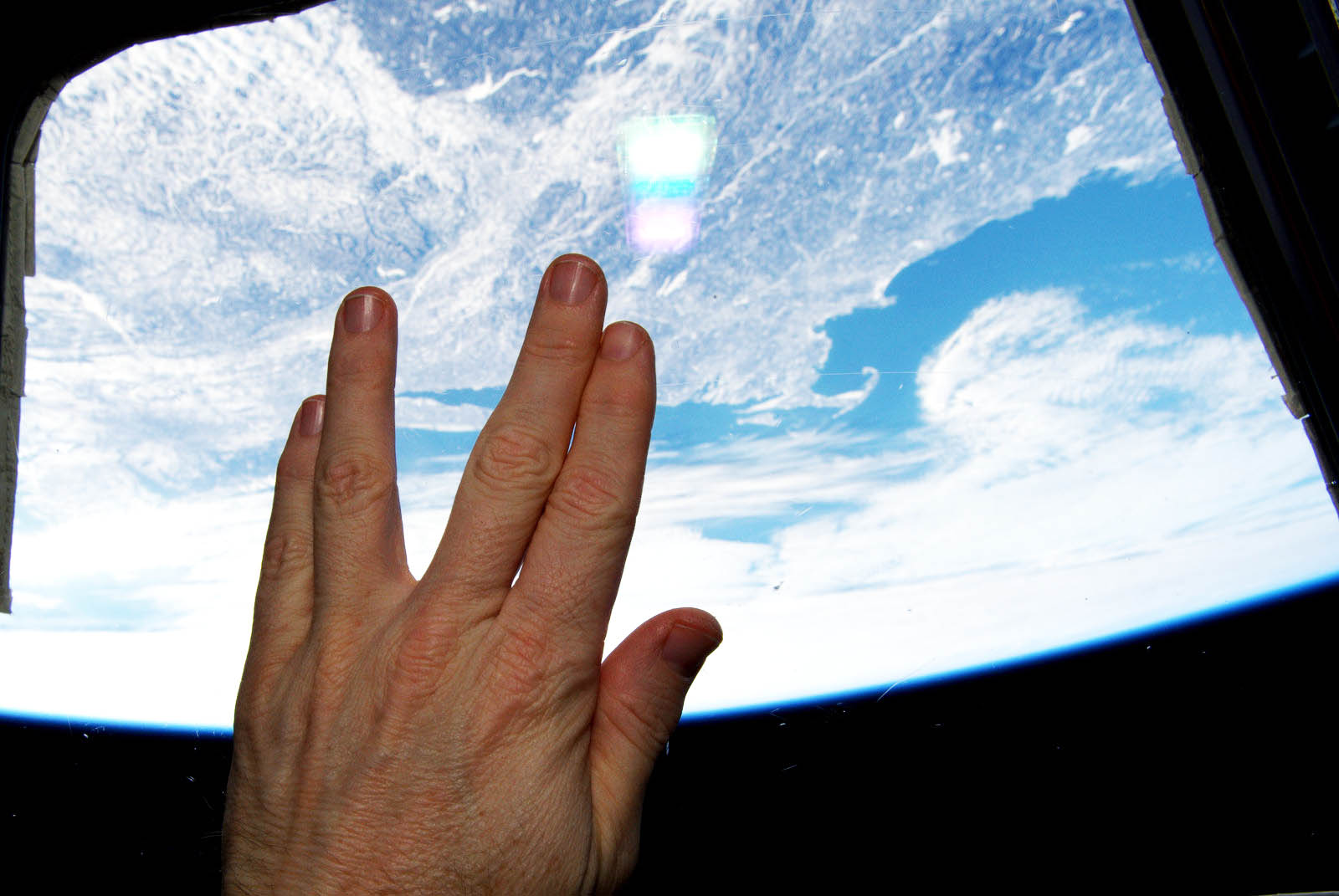'Star Trek' Cameos Help Astronauts Live Out Sci-Fi Dreams

Ensign T. Virts likely won't be crossing paths with the USS Discovery.
Last (and only) seen serving as an engineer aboard the NX-01 Enterprise in the year 2161, Ensign Virts — though of unknown age — would almost certainly be older than 100 years by the time the events of "Star Trek: Discovery" begin.
Former NASA astronaut Terry Virts, on the other hand, said he will be watching the new Trek show — which debuted on Sept. 24 — with interest.
"I was recently on a trip in Mexico with Rod Roddenberry, ["Star Trek" creator] Gene [Roddenberry]'s son, and he told me a little about it. I'll absolutely watch," said Virts, who acted as an ensign on "Star Trek: Enterprise," making him one of only three real-life space travelers to make a cameo appearance as a member of Starfleet. "That franchise has captured our hearts and minds, and there is a whole slew of people around the world who will always want to follow their adventures."
"Star Trek: Discovery" is set between the events of "Enterprise" and those of the 1966 original series. Further, "Discovery" episodes will be available on the network's premium, subscription streaming service, CBS All Access. [How to Watch "Star Trek: Discovery"]
Virts, whose first book, "View from Above: An Astronaut Photographs the World" will be published by National Geographic on Tuesday (Oct. 3), said science fiction like "Star Trek" helped him decide to become an astronaut.
"Science fiction inspired me as a kid," Virts told Space.com in an interview. "The 'Star Trek' movies, and most of all, the 'Star Wars' trilogy, really captivated me when I was a teenager. So, while I am, of course, a big fan of pursuing 'real-world' space exploration, it's the science fiction stories that really inspire us and make us dream about what the future might hold.
Get the Space.com Newsletter
Breaking space news, the latest updates on rocket launches, skywatching events and more!

"If you look at 'Star Trek,' many of their technologies have come to pass — except warp speed and the teleporter," he added.
Virts appeared alongside fellow NASA astronaut Mike Fincke in "These Are the Voyages…," the final episode of "Enterprise," in May 2005. Fincke, who is still with the space agency (Virts retired in August 2016), portrayed Lt. M. Fincke. Together with Ensign Virts, Lt. Fincke was seen in the engineering section of the spaceship, working on freeing deuterium filters.
"There's always been a link between science fiction and science fact," Fincke said in a NASA interview at the time. "Science fiction, in general, has inspired not just astronauts but all humans by giving form to our dreams to explore."
Both Fincke and Virts are veterans of expeditions on board the International Space Station. Some experiences aboard the station seemed downright sci-fi, Virts said.
"There was one night in May 2015 when [my crew and I] were flying over the southern part of the Earth, and the aurora was very strong," recalled Virts. "The southern lights were always spectacular because they were so big and prominent, but on this particular evening, we actually flew right through them.
"It was surreal to be floating in my spaceship, looking out the window and seeing this alien cloud of green, slowly dancing and wavering, surround us, above and to the right and left and below. I had the thought that this can't be real. It was like something out of 'Star Trek,'" he said.
Virts' and Fincke's appearance on "Enterprise" followed another astronaut joining the crew of the Enterprise — NCC-170D — on "Star Trek: The Next Generation."
Twenty-five years ago, Mae Jemison became the first African-American woman to fly in space, and today, she leads the 100 Year Starship project. Jemison appeared as Lt. Junior Grade Palmer, a transporter operator, in the 1993 episode "Second Chances."
In August, Jemison attended the official "Star Trek" convention in Las Vegas, where she was joined on the stage by actress Nichelle Nichols, who portrayed Lt. Uhura on the original series. Nichols was among the first African-American women to appear on television in a nonstereotypical role.
"You gave me and others permission to be in the room," said Jemison, addressing Nichols.
The lead on "Star Trek: Discovery" is African-American actress Sonequa Martin-Green, who portrays Michael Burnham, the first officer of the USS Shenzhou and USS Discovery.
It is yet to be seen if any real-life astronauts will make cameo appearances on "Discovery," though if Burnham (Martin-Green) or any of the other characters happen to look into Ensign Virts' history, there are a few things the NASA veteran would like them to find, he said.
"I would hope that they saw that I was a good officer and crewmate — maybe took part in some daring missions, hopefully saving a planet or rescuing a lost spaceship from invading aliens," Virts said.
Robert Pearlman is a Space.com contributing writer and the editor of collectSPACE.com, a Space.com partner site and the leading space-history news publication. Follow collectSPACE on Facebook and on Twitter at @collectSPACE. Follow us @Spacedotcom, Facebook and Google+. Original article on Space.com.
Join our Space Forums to keep talking space on the latest missions, night sky and more! And if you have a news tip, correction or comment, let us know at: community@space.com.

Robert Pearlman is a space historian, journalist and the founder and editor of collectSPACE.com, a daily news publication and community devoted to space history with a particular focus on how and where space exploration intersects with pop culture. Pearlman is also a contributing writer for Space.com and co-author of "Space Stations: The Art, Science, and Reality of Working in Space” published by Smithsonian Books in 2018.In 2009, he was inducted into the U.S. Space Camp Hall of Fame in Huntsville, Alabama. In 2021, he was honored by the American Astronautical Society with the Ordway Award for Sustained Excellence in Spaceflight History. In 2023, the National Space Club Florida Committee recognized Pearlman with the Kolcum News and Communications Award for excellence in telling the space story along the Space Coast and throughout the world.









